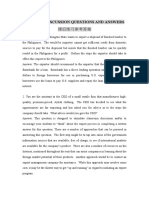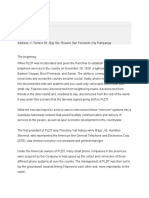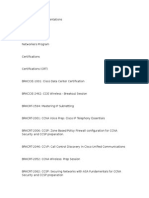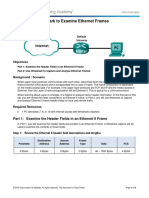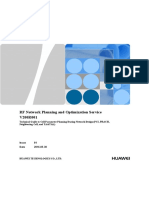Philippine Long Distance Telephone Company
Philippine Long Distance Telephone Company
Uploaded by
Lalush MustafaCopyright:
Available Formats
Philippine Long Distance Telephone Company
Philippine Long Distance Telephone Company
Uploaded by
Lalush MustafaCopyright
Available Formats
Share this document
Did you find this document useful?
Is this content inappropriate?
Copyright:
Available Formats
Philippine Long Distance Telephone Company
Philippine Long Distance Telephone Company
Uploaded by
Lalush MustafaCopyright:
Available Formats
Philippine Long Distance Telephone Company (PLDT) is the leading telecommunications provider in the Philippines.
Through its three principal business groups - fixed line, wireless, and information and communication technology - PLDT offers the largest and most diversified range of telecommunications services across the Philippines most extensive fiber optic backbone and fixed line, cellular and satellite networks. PLDT is listed on the Philippine Stock Exchange (PSE: TEL) and its American Depositary Shares are listed on the New York Stock Exchange (NYSE:PHI) and has one of the largest market capitalizations among Philippine-listed companies. Its fixed line, wireless, and information technology services are provided by their subsidiaries and affiliates: Wireless - Smart Communications, Inc. and subsidiaries, Pilipino Telephone Corporation, Telesat, Inc., Aces Philippines Cellular Site Corporation, Mabuhay Satellite Corporation; Fixed Line PLDT Clark Telecom Inc., Subic Telecommunications Company Inc., PLDT Global Corporation and Subsidiaries, PLDT Maratel, Inc., Bonifacio Communications Corporation, Smart-NTT Multimedia, Inc.; Information and Communications Technology ePLDT Inc. and Subsidiaries, ePLDT Ventus Inc., and SPi Technologies Inc.
HISTORY The beginning When PLDT was incorporated and given the franchise to establish and operate telephone services in the country on November 28, 1928, a typhoon had just ravaged Eastern Visayas, Bicol Peninsula, and Samar. The ability to communicate amongst loved ones and across the country became crucial. Sadly, phone networks then were like disconnected intercom systems and you could only call people within your own small city. Filipinos were disconnected from neighboring towns, disconnected from friends in the other island and, needless to say, disconnected from the rest of the world. It was under this scenario that the law was signed giving birth to PLDT. What the new law hoped to achieve was to interconnect these "intercom" systems into a seamless nationwide network that would facilitate communication and delivery of services to the people, as well as spur economic development in the countryside. The first president of PLDT was Theodore Vail Halsey while Major J.E. Hamilton Stevenot, who represented the American firm General Telephone and Electronics Corp. (GTE), was elected executive vice president and general manager. Under the American owners of PLDT, many small phone companies in the provinces were acquired by the Company to help speed up the rollout and connection of these different phone systems all over the country. The management of PLDT was then set to
lay the groundwork towards linking Filipinos to each other and, more importantly, to the world.
Manila-Baguio link Just a year after PLDT was given its nationwide franchise, the link between Manila and Baguio was established, making the first national long distance calls possible. Overseas radio-telephone service was also established between the Philippines and the US and other parts of the world in 1933. The first network of PLDT employed the open-wire system that was difficult to maintain and vulnerable to rain, winds, dirt, and tampering. Horse-drawn service vehicles bulky wall-mounted telephones were employed in those times. PLDT then charged a sum of P7.50 a month. The war years in the 1940's that followed proved to be devastating to PLDT as the US armed forces destroyed the PLDT system to prevent the Japanese from using it in 1941. By the time the Americans regained control, only 10 percent of the original facilities were operational.
Filipinos take control By 1968, a new era of PLDT leadership was ushered in, PLDT finally became a Filipinocontrolled corporation when Ramon Cojuangco and his group of Filipino industrialists and businessmen bought the controlling stake of GTE of New York. It was a symbol of national pride and a moment of triumph for Filipinos. Under Cojuangco's leadership, PLDT embarked on ambitious expansion campaigns that led to more Filipinos owning and benefiting from phones. Several milestones were realized in Cojuangco's time. In the same year when his group came in, the first major television broadcast via the facilities of Intelsat II-F4 and PLDT was brought to the Philippines direct from the US during the funeral of Senator Robert F. Kennedy. Another milestone in satellite communications was achieved, with PLDT playing a major role, in the subsequent remote TV coverage of the Apollo 8 flight.
Early landline innovations By 1982, direct distance dialing or DDD was becoming a byword for Filipinos. Subscribers then could call long distance to nine major cities across the nation and 22 countries around the world and reach through direct dialing more than 400 million telephones overseas. This service eventually evolved into National Direct Dialing (NDD) and International Direct Dialing (IDD) by 1985.
PLDT's ascent to greater heights of success was punctuated briefly by the death of Cojuangco in 1984. Cojuangco, who was largely responsible for the transformation of the Company from a medium-sized firm into a multi-billion-peso giant, was highly regarded by PLDT employees and considered very compassionate. It was then that Oscar T. Africa was elected as the new president while Cojuangco's son, Antonio, was elected Senior Executive Vice President. Africa, however, retired after only two years as president. Antonio Cojuangco succeeded him in 1986, ushering in a 12-year period of further expansion and robust business for PLDT. Wireless enters the scene, more innovations happen Another significant PLDT milestone was the establishment of the country's first cellular telephone network in 1987. Cellular phones then were bulky and installed only in cars. With this new service, people were able to communicate while on the go. Coverage, just like with the mobile radio-telephone service introduced in 1959, was wider, though still limited compared today. Subscribers then could make calls within Metro Manila and any place from Cavite to Baguio. A slew of new services were also introduced beginning 1992. Through a partnership with American Telephone and Telegraph Co. (AT&T). PLDT introduced the USA Direct Roving Van Service, a mobile van equipped with cellular phones, to provide toll service to some previously unserved rural communities. Other services introduced were USA Direct Mabuhay (dial access code 105-12) and Fibernet, a point-to-point international digital leased line service capable of handling simultaneous voice and data transmissions using fiber optic cables. Intelligent pay phones, which can accept coins of several denominations, were introduced. The Fonkard also came into vogue. Fonkard allowed the caller to make direct-dial national and international long distance calls through the use of prepaid magnetic telephone cards instead of coins.
Innovations beyond voice A significant milestone that changed the face of communication was the successful launching of Agila II, the country's first communications satellite, in 1997 by PLDT subsidiary Mabuhay Philippines Satellite Corp. The satellite serves the needs of customers not only in the Philippines but also other countries within the satellite's footprint in the Asia Pacific region. With the increasing importance of the Internet, PLDT signed a network deal with USbased software giant Oracle Corp. to jointly advance the development of a network computing infrastructure in the Philippines dubbed Phil-Net. A milestone for PLDT and
the development of the Internet in the Philippines would be the establishment of the country's first Internet hub called the Philippine Internet Exchange or PhIX.
Innovating Management: First Pacific entry The late '90's was a time of formidable challenges for PLDT, especially after the 1997 Asian financial crisis. Inauspicious as it may seem at the time, however, Manuel V. Pangilinan of Hong Kong-based First Pacific Co. Ltd. saw a great opportunity in taking control of PLDT. So on Nov. 24,1998, just four days before the company's anniversary, PLDT announced the entry of First Pacific which acquired a 17.5-percent stake in PLDT for approximately P29.7 billion or some $749 million at that time. The entry of First Pacific brought in a new culture in PLDT and new enterprise. Manuel V. Pangilinan replaced Antonio O. Cojuangco as president and chief executive officer. Cojuangco then assumed the position of chairman of the board. The following year, PLDT forged a strategic partnership with NTT Communications Corp (NTTCom), a wholly-owned subsidiary of Nippon Telegraph and Telephone Corp. of Japan, the world's leading telecommunications company in terms of revenues. Smart Communications, Inc. (Smart), the country's largest mobile phone operator, was also acquired by PLDT. The acquisition of Smart proved to be a wise decision, especially now that Smart is contributing greatly to PLDT's bottom line, thus buffering the telecoms giant from the debilitating effects of declining revenues from the fixed line business. Investing in ICT One of the key steps undertaken in 2000 was the formation of ePLDT, the PLDT Group's principal vehicle for investments in information and communication technology. Through its data services under the Vitro brand, its call centers under ePLDT Ventus Inc., Internet services through Infocom Technologies Inc.,data security services through mySecureSign Inc., and Internet cafe business through Netopia Technologies Inc.,the PLDT Group is now slowly reaping the fruits of its investments.
Innovating the landline Brains--an acronym for Broad and Robust ATM (asynchronous transfer mode) and Internet Networking Solutions--was launched in 2000 and made PLDT the only telecommunications company with the fastest, most reliable and cost-efficient voice, data and video transmission services running through a single multi service network.
DSL, or digital subscriber line, was also introduced in the same year. It is a broadband access technology that allows for high-speed access to the Internet via the usual copper wire lines. Other innovative services were introduced: Text 135, the country's first landline texting service; Premium Phone Services (1-908), which employed strategic tie-ups with TV game shows; Budget card for international calls; and bundling of value-added phone services such as Call Waiting, Call Forwarding, 3-party conference calls, Speed Calling, and Caller ID. When the year 2002 came, PLDT continued to innovate and introduced a pioneering prepaid landline service where subscribers can load up their phones with P500-load that is valid for two months and with a one-month reprieve to reload. In 2004, the PLDT Board of Directors appointed Manuel V. Pangilinan to the position of Chairman of the Board while retaining his post as Chairman of the Board of Smart and ePLDT. Napoleon L. Nazareno is the concurrent President and CEO of PLDT and Smart. Next Generation Network As PLDT's products and services continued to evolve, the Company began upgrading its network in 2005 to the Next Generation Network, a broad term for certain emerging computer network architectures and technologies that can encompass voice, data and video where all information is efficiently transmitted via digital packets of data just like over the Internet. This means greater efficiency, cost savings and more innovative services for subscribers in the years to come. NGN is not the goal in itself but rather a key enabler for transformation to what the PLDT Group calls Next Generation Communications. This transformation goes beyond upgrading the network to an all-IP NGN. It also involves re-engineering processes, integrating our platforms, transforming products and re-orienting people. In 2006, PLDT saw the rapid growth of its broadband business on the back of the Group's wired and wireless infrastractures. PLDT MyDSL and SmartBro broadband subscribers more than doubled to 265,000 by year end. In late 2006 and early 2007, MediaQuestHoldings - a wholly-owned subsidiary of the PLDT Beneficial Trust Fund - and Smart joined hands to conduct test broadcasts of a mobile TV service using the Digital Video Broadcast - Hand held (DVB-H) standard. This was made possible through MediaQuest's subsidiary, Nation Broadcasting Corp., which operates a network of radio and TV stations.
Culture of Innovation It's all part of PLDT's culture of innovation to bring its operations to world-class standards and become the best telecommunications company in the region. Today, PLDT leads the wireless race, dominates the landline domain, operates the premiere satellite company, and has raced to the #1 position in the Internet world, both broadband and narrow band. No doubt, PLDT is set to conquer whatever the future holds for the telecommunications industry. Notwithstanding the many technological changes that PLDT will encounter in the future, one thing will remain steadfast - its commitment to serving the nation and providing communications solutions to Filipinos. BOARD OF DIRECTORS PLDT will be the preferred full service provider of voice, video and data at the most attractive levels of price, service quality, content and coverage, thereby bringing maximum benefit to the Company's stakeholders.
Manuel V. Pangilinan, Chairman of the Board Napoleon L. Nazareno, President and CEO Helen Y. Dee Ray C. Espinosa James L. Go Setsuya Kimura Bienvenido F. Nebres, SJ (Independent Director) Hideaki Ozaki Ma. Lourdes C. Rausa-Chan Pedro E. Roxas (Independent Director) Juan B. Santos Tony Tan Caktiong Alfred V. Ty (Independent Director)
You might also like
- Globe Telecommunications Report: in Partial Fulfillment of The Requirement For The Subject Advanced Accounting IDocument41 pagesGlobe Telecommunications Report: in Partial Fulfillment of The Requirement For The Subject Advanced Accounting IPatricia Deanne Markines PacanaNo ratings yet
- Case 19 General Electric CompanyDocument2 pagesCase 19 General Electric Companymusicslave96No ratings yet
- ERP Assignment QBDocument3 pagesERP Assignment QBAbhishek Karekar50% (6)
- Philippines Telecommunications Industry Report, 2019-2025: Published: November 2019Document10 pagesPhilippines Telecommunications Industry Report, 2019-2025: Published: November 2019nguyenhaiidcNo ratings yet
- Sweet Potato Reserach Paper Group 1 2020 Final DraftDocument17 pagesSweet Potato Reserach Paper Group 1 2020 Final DraftSeth AnthonyNo ratings yet
- We See A Philippines Where Families' Dreams Come True, Businesses Flourish, and The Nation Is Admired.Document6 pagesWe See A Philippines Where Families' Dreams Come True, Businesses Flourish, and The Nation Is Admired.KennethTorricoNo ratings yet
- Globe Telecom: MCC MNC Brand Operator Status Bands (MHZ) References and NotesDocument1 pageGlobe Telecom: MCC MNC Brand Operator Status Bands (MHZ) References and NotesIvan Lopez0% (2)
- Proctor and GambleDocument19 pagesProctor and GambleNauman Rashid100% (10)
- P & G Swot AnalysisDocument8 pagesP & G Swot AnalysisSailesh RoutNo ratings yet
- Clarity PLDT OSS Case Study V2.0Document17 pagesClarity PLDT OSS Case Study V2.0Jessica Angeles67% (3)
- Ayala CorporationDocument9 pagesAyala CorporationJo AntisodaNo ratings yet
- EUROMONITOR - Sports and Energy Drinks in The PhilippinesDocument6 pagesEUROMONITOR - Sports and Energy Drinks in The PhilippinesVince Paredes100% (1)
- Case StudyDocument2 pagesCase StudyZoheel AL ZiyadNo ratings yet
- Globe TelecommuicationDocument13 pagesGlobe TelecommuicationtednorNo ratings yet
- Small-Scale Enterprise Wholesale Establishments Retail EstablishmentsDocument5 pagesSmall-Scale Enterprise Wholesale Establishments Retail EstablishmentsY D Amon Ganzon100% (1)
- Political Economic Social: Distributing Goods and ServicesDocument2 pagesPolitical Economic Social: Distributing Goods and ServicesKyrah Angelica DionglayNo ratings yet
- Huawei - TOW/SWOT/Environment/Situational AnalysisDocument10 pagesHuawei - TOW/SWOT/Environment/Situational AnalysisAlex NeohNo ratings yet
- Yriarte Jr. Ernesto S. (Activity-03 - Strategies-In-Action)Document6 pagesYriarte Jr. Ernesto S. (Activity-03 - Strategies-In-Action)Ernest S. Yriarte Jr.No ratings yet
- Cover Letter OjtDocument1 pageCover Letter OjtBeef TestosteroneNo ratings yet
- Apple Ipod Case StudyDocument22 pagesApple Ipod Case StudyNitin TiwariNo ratings yet
- Industry Trends - Evidor & Gomez HDocument41 pagesIndustry Trends - Evidor & Gomez HErika EvidorNo ratings yet
- Coach Case 4Document37 pagesCoach Case 4R K100% (3)
- Polytechnic University of The Philippines City of Santa Rosa CampusDocument160 pagesPolytechnic University of The Philippines City of Santa Rosa CampusMiguel HernandezNo ratings yet
- Netflix EnriquezDocument4 pagesNetflix EnriquezJoshua ReyesNo ratings yet
- Sony Corporation PhilippinesDocument17 pagesSony Corporation PhilippinesManuel BaalNo ratings yet
- Swot Analysis of SamsungDocument2 pagesSwot Analysis of SamsungTowsif Noor JameeNo ratings yet
- Mission AnalysisDocument9 pagesMission AnalysisTasin NasirNo ratings yet
- STP HPDocument6 pagesSTP HPPULKIT CHAUHAN100% (1)
- PrimablendDocument7 pagesPrimablendZia Irra AlegreNo ratings yet
- PLDT StramaDocument44 pagesPLDT Stramawilhelmina romanNo ratings yet
- Ethical Dilemmas - BusinessDocument2 pagesEthical Dilemmas - BusinessSahil MohammadNo ratings yet
- Critical Discussion Questions and AnswersDocument3 pagesCritical Discussion Questions and AnswersHoàng LongNo ratings yet
- Sample Event Goal and ObjectivesDocument4 pagesSample Event Goal and ObjectivesAmerie Joy TeranNo ratings yet
- 02 - Personal Quality Checklist TemplateDocument1 page02 - Personal Quality Checklist TemplatePrincess Marie JuanNo ratings yet
- Draft 11Document82 pagesDraft 11Marie Lyne AlanoNo ratings yet
- Conworld GlobalizationDocument6 pagesConworld GlobalizationAljhon Sombillo TolentinoNo ratings yet
- Chapter 3: The Environment of Marketing Channels Summary:: The Us Is Have Happen LotDocument3 pagesChapter 3: The Environment of Marketing Channels Summary:: The Us Is Have Happen Lotheize resente0% (1)
- Unilever & Diversification StrategyDocument22 pagesUnilever & Diversification StrategyHa My50% (2)
- Introduction To Mang Inasal SaveDocument11 pagesIntroduction To Mang Inasal SavekibNo ratings yet
- Executive SummaryDocument2 pagesExecutive SummaryDominic AbrahamNo ratings yet
- Jollibee Case StudyDocument2 pagesJollibee Case StudyCotton VenturaNo ratings yet
- Pilipinas Shell Presentation - Good GovernanceDocument51 pagesPilipinas Shell Presentation - Good GovernanceAngelika BalmeoNo ratings yet
- ch02 SMDocument3 pagesch02 SMTienAbleNo ratings yet
- Ranopa, Jan A. 4 BLMDocument17 pagesRanopa, Jan A. 4 BLMClaire BarrettoNo ratings yet
- Dessay Bersabal - MOIST Marketing Plan HAPEEDocument17 pagesDessay Bersabal - MOIST Marketing Plan HAPEEDessay BersabalNo ratings yet
- Samsung Marketing Strategy Case AnalysisDocument6 pagesSamsung Marketing Strategy Case AnalysisSharad PyakurelNo ratings yet
- UNILAMPDocument118 pagesUNILAMPTrisha Mae Chan CabreraNo ratings yet
- Stone Ridge Bank I. Title of The CaseDocument9 pagesStone Ridge Bank I. Title of The CaseDan GabonNo ratings yet
- Republic of The Philippines Holy Cross College of Carigara Carigara, LeyteDocument4 pagesRepublic of The Philippines Holy Cross College of Carigara Carigara, LeyteArzanne AlcoberNo ratings yet
- SM - Competitive StrategyDocument31 pagesSM - Competitive StrategygaganNo ratings yet
- Balance Score Card (Chowkinf Group)Document1 pageBalance Score Card (Chowkinf Group)Rodel LequipNo ratings yet
- QSasDocument50 pagesQSasArvin Delos ReyesNo ratings yet
- Case StudyDocument7 pagesCase StudyJasmin Amor MercadoNo ratings yet
- JOLLIBEE FOOD CORPORATION StrengthDocument1 pageJOLLIBEE FOOD CORPORATION StrengthCookies And CreamNo ratings yet
- Product Proposal: Project Feasibility (IE 309-IE32S1)Document17 pagesProduct Proposal: Project Feasibility (IE 309-IE32S1)HYASMIN MONTERONo ratings yet
- Examples of Corporate Social ResponsibilityDocument6 pagesExamples of Corporate Social ResponsibilityRebecca Chanice AcohonNo ratings yet
- STRAMAN - Workbook (Final) (2) - PASIA REYVEN DEL RIODocument40 pagesSTRAMAN - Workbook (Final) (2) - PASIA REYVEN DEL RIOWazzup BatangeñioNo ratings yet
- Why Integration Is The Key To Asia's Economic Progress? Explain Your AnswerDocument2 pagesWhy Integration Is The Key To Asia's Economic Progress? Explain Your AnswerQueeny JavierNo ratings yet
- History of PLDTDocument24 pagesHistory of PLDTBernabeth Wong MendozaNo ratings yet
- U.S. Telecom Infrastructure Crisis: America’s botched modernization of copper to fiber -- and the path forwardFrom EverandU.S. Telecom Infrastructure Crisis: America’s botched modernization of copper to fiber -- and the path forwardNo ratings yet
- Cisco 2010 All PDFDocument32 pagesCisco 2010 All PDFYibrail Veliz PluaNo ratings yet
- Seminar Topics For Sec D FinalDocument7 pagesSeminar Topics For Sec D FinalVicter PaulNo ratings yet
- TNM Lecture6Document27 pagesTNM Lecture6Animesh VentrapragadaNo ratings yet
- An Auto Ground System For Anti-Islanding Protection of Distributed GenerationDocument12 pagesAn Auto Ground System For Anti-Islanding Protection of Distributed GenerationmounikaNo ratings yet
- 5.1.1.7 Lab - Using Wireshark To Examine Ethernet FramesDocument9 pages5.1.1.7 Lab - Using Wireshark To Examine Ethernet FramesAlex Box0% (1)
- TCPIP Protocol SuiteDocument27 pagesTCPIP Protocol SuiteVedant AggrawalNo ratings yet
- Apc Cisco Sizing Guide Metro eDocument2 pagesApc Cisco Sizing Guide Metro ePatrickFayNo ratings yet
- Year 8 Computing Class: Mr. David KangDocument16 pagesYear 8 Computing Class: Mr. David KangDavid KangNo ratings yet
- Target Mep Group: (Talal Al Mathana Con. Co.)Document7 pagesTarget Mep Group: (Talal Al Mathana Con. Co.)Mohamed Abou El hassanNo ratings yet
- Ericsson Rbs 3206 PDFDocument2 pagesEricsson Rbs 3206 PDFJames0% (1)
- Digital Radio For Voice: Evolution of Radio Communication SystemsDocument17 pagesDigital Radio For Voice: Evolution of Radio Communication Systemsr0dxNo ratings yet
- 7700/7800 Frame Controller: Features & Benefi TsDocument1 page7700/7800 Frame Controller: Features & Benefi TsT AnnapooraniNo ratings yet
- RF Network Planning and Optimization Service V200R001Document295 pagesRF Network Planning and Optimization Service V200R001โดราเอม่อน คัก คักNo ratings yet
- OTC000005 OTN Introduction Issue1.04 PDFDocument70 pagesOTC000005 OTN Introduction Issue1.04 PDFchineaNo ratings yet
- Telecommunication System 1Document24 pagesTelecommunication System 1farhaniazihanNo ratings yet
- ASA 5585X in DataCenterDocument8 pagesASA 5585X in DataCenterNgo Trung KienNo ratings yet
- Alger PerformanceDocument252 pagesAlger PerformanceAbdallah CHETTAHNo ratings yet
- Ursalink UR71 Industrial Cellular Router DatasheetDocument6 pagesUrsalink UR71 Industrial Cellular Router DatasheetUrsalink MarketingNo ratings yet
- CDP & LLDP Interview QuestionsDocument6 pagesCDP & LLDP Interview Questionsخالد علي عمرNo ratings yet
- Internet Access Via Cable TV NetworkDocument15 pagesInternet Access Via Cable TV Networkankur_desai100% (1)
- Fortios Handbook 56Document3,447 pagesFortios Handbook 56davidNo ratings yet
- Physical Layer:: SwitchingDocument27 pagesPhysical Layer:: SwitchingPKSachanNo ratings yet
- Faculty of Inforamation Technology and Communication Studies. Department of Information Technology Studies LEVEL 200Document33 pagesFaculty of Inforamation Technology and Communication Studies. Department of Information Technology Studies LEVEL 200Bra Kofi TheophilusNo ratings yet
- Simple and Powerfull Firewall FilterDocument4 pagesSimple and Powerfull Firewall FilterDedl SupraNo ratings yet
- FortiGate VM AzureDocument6 pagesFortiGate VM AzureGERMINNo ratings yet
- CCENT (ICND1) Practice Certification Exam - Online AssessmentDocument36 pagesCCENT (ICND1) Practice Certification Exam - Online AssessmentAbbas ShahidNo ratings yet
- Etworking Interview Questions and Answer 1Document5 pagesEtworking Interview Questions and Answer 1Mohd Tanveer AshrafNo ratings yet
- 20180124101654EchoLife HG8145V GPON Terminal - EngDocument6 pages20180124101654EchoLife HG8145V GPON Terminal - EngPranav Shah100% (1)
- COMPUTER NETWORK-BY Ankit PatnaikDocument18 pagesCOMPUTER NETWORK-BY Ankit PatnaikTuhina MistryNo ratings yet
- 3G Mobile CommunicationDocument27 pages3G Mobile CommunicationTechy GuyNo ratings yet































